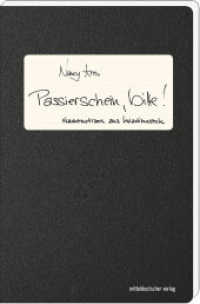- ホーム
- > 洋書
- > ドイツ書
- > Mathematics, Sciences & Technology
- > Technology
- > mechanical engineering & production engineering
Full Description
This second of three volumes includes papers from the second series of NODYCON which was held virtually in February of 2021. The conference papers reflect a broad coverage of topics in nonlinear dynamics, ranging from traditional topics from established streams of research to those from relatively unexplored and emerging venues of research. These include
· Nonlinear vibration control
· Control of nonlinear systems and synchronization
· Experimental dynamics
· System identification and SHM
· Multibody dynamics
Contents
Chapter 1. Topological optimisation of friction dampers for nonlinear resonance mitigation.- Chapter 2. Experimental study of a nonlinear energy sink based on a cantilever beam under special boundary conditions.- Chapter 3. Equivalence of grounded and non-grounded NES's tuning and performance in mitigating transient vibrations.- Chapter 4. Dynamic performances of a 2 d.o.f. system coupled with rigid block and inerters.- Chapter 5. Fuzzy Model Predictive Pitch Control of Flexible Wind Turbine Blade.- Chapter 6. Nonlinear flutter suppression of composite panels with nonlinear energy sinks.- Chapter 7. Suppression of vibration transmission between oscillators coupled with a nonlinear inerter-based joint.- Chapter 8. Optimal direct adaptive model-free controller for twin rotor MIMO system using Legendre polynomials and PSO algorithm.- Chapter 9. Dynamics and Performance Analysis of a Nonlinear Energy Sink with Geometric Nonlinear Damping.- Chapter 10. Aeroelastic dynamic feedback control of a Volterra's airfoil.- Chapter 11. Determining magnetic and electromagnetic springs forces and their usage in damping vibrations.- Chapter 12. A novel methodology for controlling stick-slip vibrations in drill-strings.- Chapter 13. Suppression of Sommerfed Effect on a cantilever beam through a viscoelastic dynamic neutralizer.- Chapter 14. Stabilisation of unstable responses on a heavy-chain model by means of parametric excitation.- Chapter 15. A new semi-active control method of yaw damper in high-speed railway vehicle and its experiment in hardware-in-the-loop system.- Chapter 16. Analysis of half-car model with nonlinear damper under sinusoidal road excitation.- Chapter 17. An optimal fractional LQR-based control approach applied to a cart-pendulum system.- Chapter 18. Nonlinear viscoelastic damping for seismic isolation.- Chapter 19. Optimal design and seismic performance of nonlinear TMD with pinched hysteresis.- Chapter 20. Vibration control of a cantilever beam coupled to a non-ideal power source by coil impedance matching.- Chapter 21. Variable Length Sling Load Hoisting Control Method.- Chapter 22. Dynamic actuation model for vibration reduction in offshore cranes.- Chapter 23. Improving energy efficiency of a bipedal walker with optimized nonlinear elastic coupling.- Chapter 24. A study on control of chaotic system.- Chapter 25. Stabilizing-delay-based impulsive control for cluster synchronization of nonlinearly coupled Lur'e networks.- Chapter 26. Influence of sea currents on the strategy of riser re-entry.- Chapter 27. Continuous Leaderless Synchronization Control of Multiple Spacecraft on SO(3).- Chapter 28. Preliminary experimental study on the influence of the gap in a vibro-impact system with two-sided constraints.- Chapter 29. Experimental characterization of nonlinear pilot induced oscillations using a flight simulator.- Chapter 30. Recurrence plot quantification analysis of greyhound galloping gait.- Chapter 31. Towards a high-performance Foucault pendulum for the measurement of relativistic gravity.- Chapter 32. Identification of Non-polynomial forms of Damping Nonlinearity in Dynamic Systems using Harmonic Probing and Higher Order FRFs.- Chapter 33. Identification of nonlinear damping using nonlinear subspace method.- Chapter 34. Nonlinear restoring force subspace identification of negative stiffness nonlinear oscillators.- Chapter 35. Accurate model identification of quadcopters with moments of inertia uncertainty and time delay.- Chapter 36. Nonparametric Identification of a Nonlinear MEMS Resonator.- Chapter 37. Mine clearance through an artificial intelligence flying drone.- Chapter 38. A new approach for structural health monitoring: damage detection on large structures through a swarm of moving sensors.- Chapter 39. Identification of robot quadrupeds' gait by genetic algorithm.- Chapter 40. Proper and Smooth Orthogonal Decompositions for Detection of Gear System Defects in Rotating Machinery.- Chapter 41. On the physical consistency of evolution laws obtained with sparse regression.- Chapter 42. Linear stability analysis of a bicycle multibody model with toroidal wheels.- Chapter 43. Co-simulation in mechanical systems with nonlinear components.- Chapter 44. A novel time-stepping method for multibody systems with frictional impacts.- Chapter 45. Generalized SLIP Model For Legged Robots.- Chapter 46. On the mobility of a robot-trajectory process.- Chapter 47. Multiple Sommerfeld Effects in Nonlinear Vehicle Road Dynamics.- Chapter 48. A forward dynamics methodology to study nonlinear dynamics and wear of total knee arthroplasties.- Chapter 49. Solving Non-smooth Dynamic Problems using the Alternating Direction Method of Multipliers.- Chapter 50. PyChrono and gym-chrono: a Deep Reinforcement Learning framework leveraging Multibody Dynamics to control Autonomous Vehicles and Robots.







